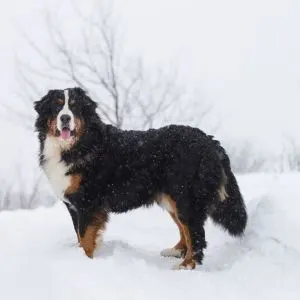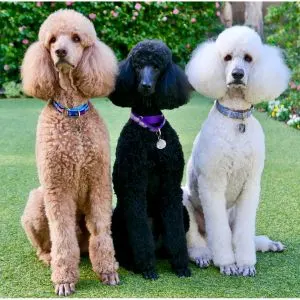Updated 03/14/2024 with new pictures: Have you ever wondered what makes the Bernedoodle such a beloved companion? Well, you’re not alone!
Bernedoodles, a mix of the intelligent Poodle and the loyal Bernese Mountain Dog, have captured the hearts of dog lovers everywhere. These charming dogs are known for their friendly disposition, fluffy coats, and intelligent eyes that seem to understand just what you’re feeling.
In this guide, we’ll dive into what makes Bernedoodles so special, from their unique traits to lesser-known facts that make them more than just a ‘cute face’.
Whether you’re a seasoned Bernedoodle owner or just curious about this delightful breed, there’s something here for everyone. Let’s uncover the joy and allure of owning a Bernedoodle together!”- that includes, in addition to basic information, real-life experiences from people who share their lives with a Bernedoodle.
But first, did you know that the Bernedoodle goes by several names?
While ‘Bernedoodle’ (sometimes spelled Bernadoodle or Berniedoodle) is the most commonly used term, these lovable dogs are often affectionately called ‘Bernepoos’ or ‘Doodle Bernes’ by their fans. Some enthusiasts prefer ‘Bernese Mountain Poos’ to emphasize their Bernese Mountain Dog heritage.
You might even hear them referred to as ‘Bernese Poodles’ in some circles. These names not only reflect the breed’s mixed heritage from the Poodle and the Bernese Mountain Dog but also capture the playful and affectionate nature of these dogs.

Bernedoodle History and Origin
Berniedoodle History
The Bernedoodle is a relatively recent addition to the world of designer dogs, but its parent breeds, the Bernese Mountain Dog and the Poodle, are purebred dogs with rich histories that contribute to the unique characteristics of the Bernedoodle.

Bernese Mountain Dog
Originating from the Swiss Alps, the Bernese Mountain Dog. a working breed, is known for its strength, agility, and gentle disposition. Historically, these dogs were used as farm dogs in the Swiss mountains, where they were valued for their ability to herd cattle, pull carts, and serve as loyal companions to the farmers. Their long, silky fur, marked by distinctive tricolor patterning, provided insulation against the cold mountain climates. The breed is known for its loyalty, affectionate nature, and a strong desire to please its owners.

Poodle
The Poodle, renowned for its intelligence and elegance, has its origins traced back to Germany and France. Contrary to popular belief, Poodles were originally bred as water retrievers, their unique coat helping them navigate cold waters. Poodles come in three sizes (standard, miniature, and toy), and it’s typically the standard Poodle that’s used to breed Bernedoodles. Poodles are highly intelligent, easy to train, and known for their hypoallergenic coats, which is a trait often sought after in designer dog breeding.
The Origin of the Bernedoodle
The Bernedoodle was first intentionally bred by Sherry Rupke of SwissRidge Kennels in 2003. Sherry Rupke, who had experience breeding both Bernese Mountain Dogs and Goldendoodles, sought to create a breed that combined the best traits of the Bernese Mountain Dog and the Poodle. Her goal was to produce a dog that had the intelligence, playfulness, and hypoallergenic coat of the Poodle, along with the gentle, friendly, and loyal nature of the Bernese Mountain Dog.

Bernedoodle Physical Characterisitcs
Bernedoodle Appearance
The Bernedoodle is a visually striking mix of its Bernese Mountain Dog and Poodle parents. They typically have a wavy to curly coat, displaying colors ranging from the Bernese’s classic tricolor to solid and bi-color variations. Bernedoodles come in a few different sizes: the standard size, the medium-sized miniature, and the small toy. They have a robust and muscular build with a harmonious physique, and their faces feature a blend of the Poodle’s fluffy look and the Bernese’s gentle expression.
Bernedoodle Size
Bernedoodles come in three main sizes: standard, miniature, and tiny (or toy), each resulting from different breeding practices involving a purebred Poodle and the Bernese Mountain Dog. Additionally, the generation of the Bernedoodle also plays a significant role in determining their size.
Standard Bernedoodles
Bred from a standard Poodle and a Bernese Mountain Dog, these are the largest, typically weighing 60 to 90 pounds and standing around 23 to 29 inches tall. They inherit the sturdy build of the Bernese and the size of the standard Poodle.
Miniature Bernedoodle
Created by breeding a miniature Poodle with a Bernese Mountain Dog. This size variation is smaller, usually weighing between 25 to 50 pounds and standing about 18 to 22 inches tall. Mini Bernedoodles are a good choice for those who love the Bernedoodle’s traits but prefer a smaller, more manageable-sized dog.
Toy or Tiny Bernedoodle
The smallest variation, bred from a toy Poodle and a Bernese Mountain Dog, or more commonly, with a mini Bernedoodle. They weigh 10 to 24 pounds and stand approximately 12 to 17 inches tall, ideal for smaller living spaces.
If you are looking for a smaller doodle you may want to also check out the Cockapoo and Cavapoo
To learn more about when a Bernedoodle will reach their adult size, check out our post on Bernedoode Full Grown: How big do they get?

Bernedoodle Coat Types
The Bernedoodle’s appearance, particularly their coat type, is significantly influenced by both their Bernese Mountain Dog and Poodle ancestry, as well as the specific generation of Bernedoodle.
Generation Impact on Coat Types:
F1 Bernedoodles (First Generation)
These are direct offspring of a Poodle and a Bernese Mountain Dog. Their coats can vary widely, often being a mix of wavy and curly types, as they inherit 50% of each parent’s coat characteristics.
F1 b Bernedoodles (Backcross)
This generation is created by breeding a Bernedoodle with a Poodle, resulting in a genetic makeup that is 75% Poodle and 25% Bernese Mountain Dog. F1b Bernedoodles often have curlier coats that more closely resemble the Poodle’s.
F2 Bernedoodles (Second Generation)
The result of breeding two F1 Bernedoodles. Their coats can be quite varied, with some inheriting more of the Poodle’s curly coat and others showing the wavier coat of the Bernese Mountain Dog. The predictability in coat type decreases with this generation, offering a broad spectrum of coat textures.
F2b Bernedoodles and multigenerational Bernedoodles
In these generations, a Bernedoodle (F1 or F2) is backcrossed with either a Poodle or a Bernedoodle, or two F2 Bernedoodles are bred together. These generations can produce an even wider range of coat types, from straight to curly.

Bernedoodle Coloring
Bernedoodles commonly exhibit several coat colors and patterns, including:
- Tricolor: This pattern is highly popular and mirrors the Bernese Mountain Dog’s look. It features a black base with distinct white and brown markings, often seen on the face, chest, and paws.
- Bicolor: Typically, this involves combinations like black and white or black and brown. Bicolor Bernedoodles have a predominantly black coat with contrasting white or brown patches.
- Solid color: Quite common, these Bernedoodles have a uniform coat, influenced primarily by the coloring of the Poodle parent.
- Phantom: Lacking the white of the tricolor, phantom Bernedoodles have a primarily black coat with tan or brown highlights, particularly around the eyes, muzzle, and legs.
These are among the most frequently observed colors in Bernedoodles. However, they can also showcase a range of other hues and patterns, influenced by the genetic diversity of their parent breeds. It’s also noteworthy that Bernedoodle puppies can experience changes in their coat color as they grow older.
Temperament and Personality
Bernedoodle Temperament
The Bernedoodle, is known for its affectionate nature and intelligence. These dogs are often easy to train due to their smart Poodle lineage and exhibit a playful, gentle demeanor from their Bernese side. They form strong attachments to their families, making them loyal and loving pets. Bernedoodles are generally good with children and other pets, thanks to their friendly disposition.
However, they are not without their challenges. Their high intelligence and energy require regular mental and physical stimulation to prevent boredom-related behaviors. Lack of activity can lead to anxiety and destructive actions like chewing or excessive barking. Bernedoodles can also display stubbornness, a trait that calls for consistent and patient training. Their strong attachment can lead to separation anxiety if left alone too much. Early socialization is key to prevent cautiousness around strangers or new situations
When asked this is how Bernedoodle parents describe their dogs.
- Easiest dog I ever had
- Sweet; a herder, but a bit aloof
- Wants attention
- Zen
- Calm; easy to train
- Good energy level and personality;
- Friendly and loves children, needy
- Less energetic then a Goldendoodle
- Goofy, affectionate, but also skittish
- Laid back and easy going, stubborn
- Mouthy and vocal
- Has stranger danger
- Smart, but stubborn
As you can see most people agree that the Bernese Mountain Doodle is a smart, calm but playful, easy going dog. But some can inherit stubbornness and the wariness of strangers. In the end their individual temperament will depend on their breeding and socialization.

Exercise Requirements by size
The exercise requirements for Bernedoodles vary based on their size—standard, miniature, or tiny/toy—and individual energy levels. However, all Bernedoodles benefit from regular physical activity and mental stimulation.
- Standard Bernedoodles: Need at least about 60 minutes of daily exercise. Activities like long walks, hikes, and dog sports are ideal. As working dogs they enjoy being active.
- Miniature Bernedoodles: Moderately active, requiring around 45 to 60 minutes per day. Brisk walks and interactive games suit them well.
- Tiny/Toy Bernedoodles: The smallest, needing about 30 to 45 minutes of daily activity. Short walks and indoor play are sufficient.
When do Bernedoodle Puppy start to calm down?
Like all dogs, Bernedoodle puppies requires more exercise than an adult dog, However, many owners report that their Bernedoodle puppies start showing signs of settling down around the age of 6 to 8 months, which is relatively earlier compared to many other breeds.

Health and Lifespan
Health
Bernedoodles, can enjoy the benefits of hybrid vigor, which can reduce the incidence of certain genetic health issues. Therefore, they are considered to be a relatively healthy breed as compared to the Bernese. Bernese Mountain Dogs have a short life span.
However. they are still prone to a range of health problems, including an increased risk of cancer. The Bernese Mountain Dog has a fifty percent rate of cancer, while the poodle has a forty percent rate of cancer. Other potential health issues in Bernedoodles include:
- Hip Dysplasia and Elbow Dysplasia: Common in larger breeds, these conditions cause joint malformation, potentially leading to arthritis or lameness.
- Eye Disorders: Bernedoodles may inherit cataracts, progressive retinal atrophy, and glaucoma, impairing vision.
- Skin Issues: They can be prone to conditions like hot spots, allergies, and sebaceous adenitis, a skin gland disorder, linked to their Poodle genetics.
- Addison’s Disease: This adrenal gland disorder, more prevalent in Poodles, can manifest with a range of symptoms, including gastrointestinal distress and lethargy.
- Von Willebrand’s Disease: A clotting disorder causing excessive bleeding from injuries or surgeries.
- Bloat (Gastric Dilatation-Volvulus): A serious risk in larger Bernedoodles, where the stomach fills with gas and twists.
- Ear Infections: Their floppy ears are susceptible to infections if not regularly cleaned.
Please note this is not a complete list of health concerns for the Bernedoodle.
Bernedoodle’s Life Expectancy
The Bernedoodle is considered to be a relatively healthy breed as compared to the Bernese. Bernese Mountain Dogs have a short life span of only 6 to 8 years.
But since the breed is still relatively new the actual average lifespan is still unknown. Below is the stated lifespan based on breeders claims.
Bernedoodles have a lifespan as follows:
- Standard Bernedoodles: Being the largest, they typically have a lifespan of around 12 to 15 years.
- Miniature Bernedoodles: These medium-sized dogs often live a bit longer, typically around 14 to 17 years.
- Tiny or Toy Bernedoodles: The smallest variety can have the longest lifespan, often living up to 18 years or more.
These are general estimates, and individual lifespans can vary based on factors like genetics, overall health, diet, and exercise. Regular veterinary care and a healthy lifestyle can help maximize a Bernedoodle’s health and lifespan.

Getting a Bernedoodle
Where to Find A Bernedoodle?
Finding a Bernedoodle requires some research, especially if you’re looking for a healthy and well-tempered dog. The key is to seek out reputable bernedoodle breeders who are known for their responsible breeding practices. Here are some tips on where to find a Bernedoodle:
Reputable Breeder: Start by searching for breeders who specialize in Bernedoodles. Reputable breeders are dedicated to the health and temperament of their dogs, often referring to them as “gentle giants” due to their friendly and calm nature. These breeders conduct thorough health screenings and genetic tests to ensure the well-being of the puppies and the breed as a whole.
Rescue Organizations and Shelters: Don’t overlook rescue organizations and shelters. While Bernedoodles are a unique mix, they do sometimes end up in shelters or in the care of rescue groups.
You can sometimes find a Bernedoodle at a local shelter, because some people who shouldn’t get a Bernedoodle. don’t do their research first.
Cost of a Berne doodle
The typical price for a health-tested Bernedoodle ranges from $3,000 to $5,000, with the sought-after tricolor variety often at the higher end of this spectrum. For those looking to bypass the early training challenges, opting for a pre-trained puppy can increase the cost significantly, up to around $28,000.
Looking for a name for your large dog? Check out our list of Big Dog Names: 300+ Names From the Classic to the Unique

Lesser Known Facts About the Bernedoodle Only Owners Know
1. It’s common for Bernedoodle puppies to Sploot
Never heard of splooting? Splooting is when a dog lays flat on their stomach with their back feet and legs stretched either behind them or off to the sides. In the picture below can see a dog doing both veriations.
It’s pretty funny to see since they look like a frog from above. It’s believed that they do this to either stretch out their legs or to cool off by placing their belly on a cold surface. While this is more common in puppies, some adult dogs can also lay this way.

2. Mini is a relative term when it comes to the Bernedoodle
In general because the Bernese Mountain dog is an ex-large dog breed the mini and the micro Berne doodle will be larger than other mini doodles.
For example the Mini Berniepoo is 18 to 22 inches tall and between 25-50 lbs but the mini Labradoodle is only between 14 to 16 inches tall and 15 to 25 pounds.
So although they are billed as a “mini”, the size is in relations to the size of a full sized Berne doodle. When looking for a mini, make sure to ask about the parent’s sizes.
3. Your Bernedoodle might be part Labradoodle
Some breeders chose to use an Australian Labradoodle (ALD) instead of a poodle to breed a Bernedoodle. These pups are generally referenced to as an Australian Bernedoodle.
Although reasons may vary, one breeder’s reason to use an Australian Labradoodle was that they felt the Bernese and ADL was a better match in both temperament and structure.
This results in a more consistent look for the puppies. Also using wavy or straight haired ADL results in a Berne doodle that is low-shed but without the curly coat.
For more little known facts about the Bernedoodle check out our post on Bernedoodle: 20 Facts You May Not Know
Can’t decide between the Bernedoodle and the Bernese Mountain Dog? Check out our post Bernedoodle vs Bernese Mountain Dog: 12 Key Differences
Bringing Home, a Bernedoodle Puppy
Once you decide you want a Bernedoodle, you should start thinking about what you need for when you bring your puppy home. Puppies require many things, like a leash and collar, food bowls and toys.
One of the things you might not think about is where your puppy will go to the bathroom. Having an established place to train your puppy to go outside will make potty training easier. To learn more, check out our posts on Potty Training a Puppy: Made Easy and Outdoor Dog Potty Area Guide.
For naming ideas check out our post on 775+ Bernedoodle Dog Names: The Ultimate
